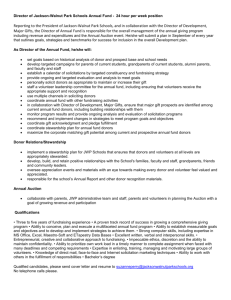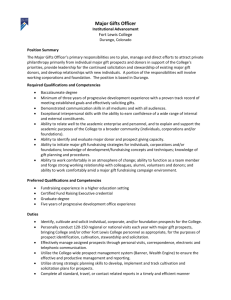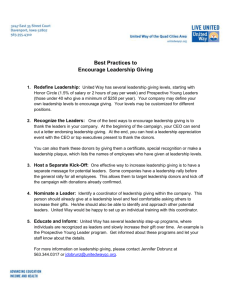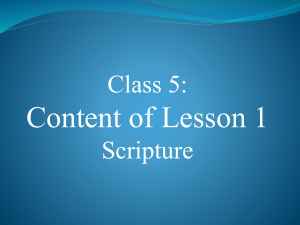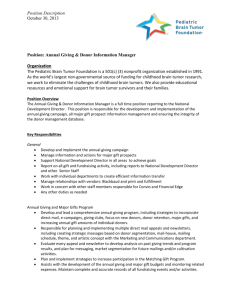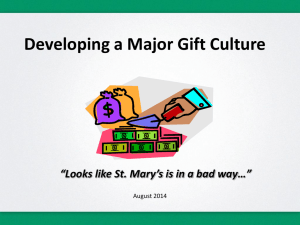Why People Give
advertisement
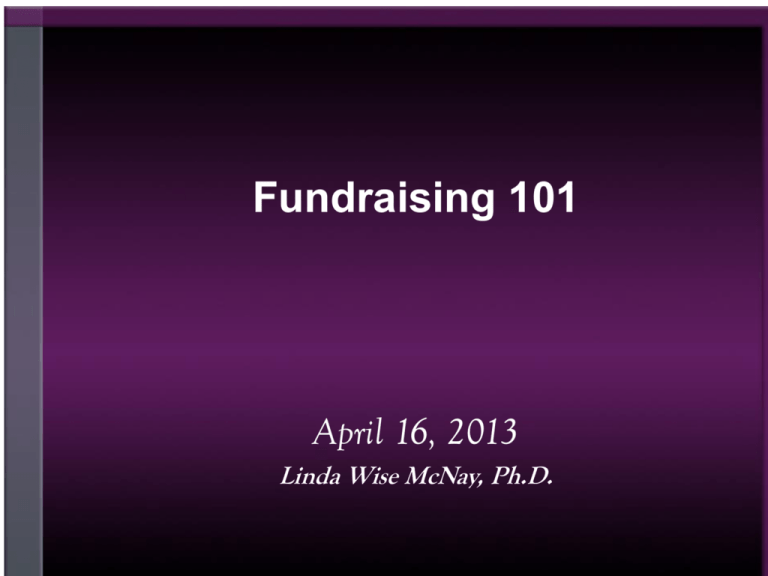
Fundraising 101 April 16, 2013 Linda Wise McNay, Ph.D. Types of Recipients of Contributions, 2011 Total = $298.42 billion 2011 Charitable Giving Total = $298.42 billion Successful Fundraising/Sustainability Requires • Vision and Mission • Case for Support • Leadership (Board and Head of School) – Understand and Implement principles of effective fundraising – Participation – Oversight • Strategy/Development plan. 4 Fundraising for Independent Schools is Unique • Daily interaction • Strong Annual Fund is important • Competing interests (annual fund, PTO, etc.) • Turnover rates • Alumni participation • Parent education. 5 Vocabulary • • • • • • Annual Fund Major Gifts Capital Campaign Planned Gifts Special Events Comprehensive Campaign. 6 The philanthropic process is more about relationships than money. 7 Development Cycle Research Stewardship Identification Closure Research Solicitation Cultivation Research 8 Annual Giving • Building block upon which organizations succeed or fail • Money for current use • Provide operating support for on-going programs – Unrestricted – Restricted – Size isn’t relevant. 9 Capital Giving • Intensive, organized effort • Secure gifts for specific capital needs or projects • Within a specific time period (usually over one or more years) • Requires study, planning and identification of major gifts prospects • Lays groundwork for involving new volunteers, donors • Sets stage for high annual giving levels. 10 Planned Giving • Integration of sound personal, financial, and estate planning concepts with donor’s plan for lifetime or testamentary giving. 11 Solicitation Staircase Face to Face Small Group Phone Handwritten Letter Typed Letter E-Mail Video Mass-produced Letter Newsletter News Item Advertisement 12 Board Leadership • Ensure fiduciary responsibilities • Act in an ethical manner and expect ethical behavior • Avoid conflict of interest • Keep information confidential • Serve on one or more committees • Attend all meetings • Provide oversight for prevention of fraud. 13 Board Leadership • Annual – this should be one of your top three giving priorities • Planned Gift – work toward a deferred gift such as a bequest, life insurance, trust or other • Make a meaningful capital/major gift • Participate in fundraising activities. 14 Board Member’s Fundraising and Stewardship Duties • • • • • • • • Top 3 personal philanthropic priority Identify and evaluate prospects Cultivate and solicit gifts Host fundraising or stewardship events Support fundraising programs and events Offer personal acknowledgements Provide leadership and actively advocate Ensure funds are used as designated. 15 Role of Development Committee • • • • Monitor all fundraising activities Plan for special initiatives Solicit Board peers Be active in identification/cultivation/solicitation/ stewardship • Ensure sufficient resources. 16 Fundraising Myths 17 Special events are an easy way to raise lots of money. 18 This was not intended to be a fundraising board. 19 We need a “famous” honorary campaign chair. 20 We don’t need to have any campaign committee meetings. 21 It’s the staff’s job to raise all of the money. 22 We have staff, we don’t need a consultant. 23 We can’t ask people for a specific gift amount. 24 We’ll get 1000 people to give $1,000 to make $1,000,000. 25 If we can just get publicity for the campaign, money will pour in. 26 We can borrow money to build and raise it later. 27 We can’t go back to our past donors, this money will have to come from new donors. 28 Our big gift will be from someone we don’t know yet. 29 Let’s go to Mr. Moneybags, he could give the whole amount and not miss it. 30 Personal Giving Findings 80% donate to charity 48% volunteer 45-50 age group gave and volunteered more $60,000-$90,000 income level gave and volunteer more 14% had established long-term giving plans. Why People Give Because they are asked In person By the right person For the right amount For the right project At the right time. The Model Donor Major Annual Lifetime Gift. Case Create Emotional Connection: How will this affect the organization? How will it affect the donor? How is this an opportunity for the donor? Case How to Give? Methods of payment Time period Type of gifts accepted Tax deductible Where should the gifts be sent? Contact person. Case Summary: Component and cost list Benefit to donor Ask. Who is a Major Gift Prospect? • • • • • Connection Good relationship Ability to give Past giving history Desire for recognition. How to ID Major Gift Prospects • Qualify your prospects • Screening sessions • Develop process for clearance and management • Conduct proper research – Interest – Do they care? – Ability? Importance of Cultivation • • • • Increase interest Build awareness Establish trust Reinforce connection to the School. Cultivation Examples • • • • • • • • Donor dinner Invitation to lecture/presentation Stewardship report on past giving Involvement on committee or board Meeting with Head of School Phone call/email Information mailing Request for advice. Features of Major Gift Solicitations • Carefully tailored and personalized strategy • Potential long cultivation period • Matchmaking critical – Staff/volunteer contacts – Project identification – Cultivation activities – Consistency, quality and frequency. What Occurs on a Major Gift Call? • • • • • • • Building relationships Communicating face-to-face Information sharing Common goals and values Leveraging opportunity Providing service Determining needs and interests. Stewardship of Major Gift Donors • Is this important? ASK donor about recognition • Know what is available and suitable • Provide it! • Enroll in gift club • Written thank you notes from others • Personalized recognition lunch or dinner. Why Is Stewardship Important? • • • • • • To ensure “feel good” Report back to donors To reinforce the importance of the gift To facilitate communication To leverage future gifts To keep donors engaged. Essential to Major Gift Success • • • • • • Long term investment in process Consistency and quality of activity Personalized approach Continual evaluation and fine tuning Sensitivity to prospect’s time line Appropriate use of volunteers. Integrating with Rest of Development Office • Coordinate with entire development effort • Use of volunteers? • Define role of Major Gifts Committee. Integrating with Rest of Development Office • Management and accountability of staff – Define in writing yearly expectations and quantifiable goals jointly decided between supervisor and professional • Dollar benchmark goals – – – – Qualification calls Cultivation calls Solicitations Stewardship calls • # Contacts • # Proposals. Evaluating Your Major Gift Program • How did we do in comparison to our written MG plan? Number of prospects? Dollars raised? • Are MG initiatives consistent with strategic plan? • Was each MG prospect “developed” successfully according to their level of awareness, understanding, involvement and commitment? • Is the staffing and budget sufficient to support gift potential? How Long Does It Take? “If you want to raise alfalfa, you can get several crops a year. But if you want to raise oaks, it will take a little longer.” --Si Seymour Questions? Thank You
